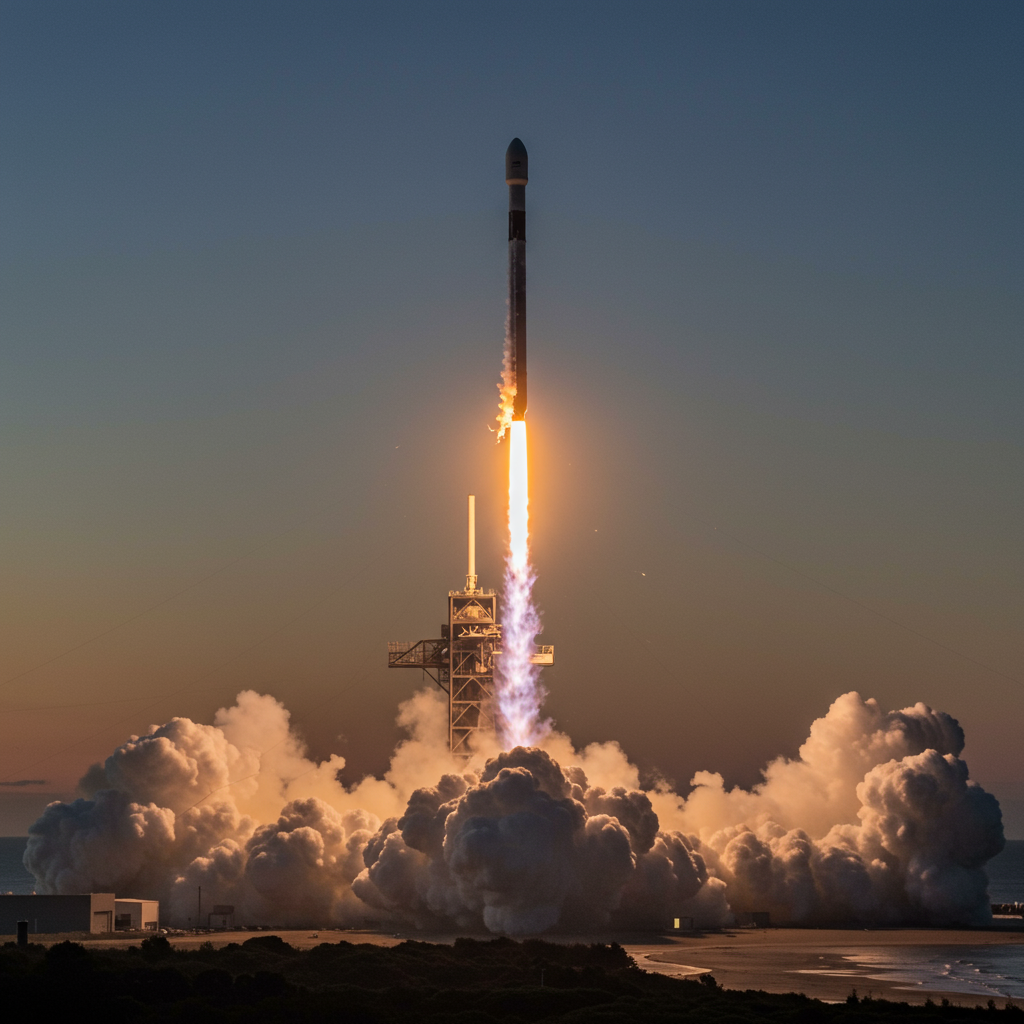SpaceX is poised for a landmark moment, preparing to launch its 500th falcon 9 rocket on an upcoming starlink mission. This significant achievement highlights the sheer operational tempo and reliability of the world’s most active launch vehicle. Scheduled for an early morning liftoff on Wednesday, July 1, 2025, this mission, designated Starlink 10-25, adds another chapter to SpaceX’s relentless pursuit of reusable spaceflight.
The launch is set to occur from Space Launch Complex 40 (SLC-40) at Cape Canaveral Space Force Station in Florida. Anticipation is building for the 1:29 a.m. EDT (0529 UTC) liftoff. Forecasters predict highly favorable conditions, with the 45th Weather Squadron indicating a 90 percent chance of good weather. Only a minimal risk exists from cumulus clouds.
This mission carries double significance. It marks the 500th flight specifically for the Falcon 9 variant, a workhorse that has revolutionized orbital access. This follows closely on the heels of the 500th overall orbital launch milestone for the broader Falcon family (including Falcon 1, Falcon 9, and Falcon Heavy), which SpaceX achieved earlier in June 2025 from Vandenberg Space Force Base. That earlier mission underscored the Falcon family’s collective impact. This latest launch celebrates the Falcon 9’s individual dominance.
A key element of this particular Starlink flight is the Falcon 9 first stage booster, tail number B1067. This booster is attempting a record-setting 29th flight. Its extensive flight history demonstrates SpaceX’s incredible strides in rocket reusability. B1067’s resume includes supporting four critical Dragon missions for NASA (two crew and two cargo flights to the ISS). It also launched the Turksat 5B satellite. Additionally, this veteran booster has delivered seventeen prior batches of Starlink satellites to orbit.
The ability to rapidly reuse rocket components is central to SpaceX’s business model. It dramatically reduces launch costs. This record 29th flight further proves the durability and reliability of the Falcon 9 design. This model has allowed SpaceX to become the leading global launch provider.
Following its primary mission of lofting the Starlink satellites, the B1067 booster will attempt a precision landing. The target is the autonomous droneship ‘A Shortfall of Gravitas’. This vessel is stationed offshore in the Atlantic Ocean. A successful landing would be the 116th touchdown recorded on this specific droneship. It would also contribute to SpaceX’s impressive overall tally of recovered boosters. This tally would reach 472 successful landings to date.
The Starlink constellation is a vast network providing high-speed internet globally. It is the world’s largest satellite network. It currently comprises over 7,600 active satellites. The network continues to grow rapidly. Some newer satellites are equipped with direct-to-cell capabilities. This enables basic connectivity for compatible smartphones.
SpaceX’s rapid operational tempo is fueling this constellation build-out. In 2024, the company conducted a record 134 launches. They are targeting an even higher number in 2025, potentially reaching 170 missions. This high flight rate is only possible because of the proven reusability of the Falcon 9 and Falcon Heavy.
This continuous stream of launches supports SpaceX’s ambitious financial goals. The company projects generating $15.5 billion in revenue during 2025. This significant revenue stream is largely driven by the demand for Starlink services and launch contracts. This commercial success provides vital funding for SpaceX’s long-term aspirations.
SpaceX CEO Elon Musk has openly linked the success of the Falcon program and Starlink to funding the development of the Starship system. The much larger, fully reusable Starship is designed for interplanetary travel. Musk envisions Starship as the vehicle to make humanity multi-planetary. This includes establishing a presence on Mars. Musk has acknowledged the role of Starlink customers in supporting these grand objectives.
The 500th Falcon 9 launch represents more than just a number. It symbolizes the maturity and incredible capability of a rocket that has fundamentally changed access to space. It also highlights the sustainable model of reusability. This model is paving the way for future space exploration endeavors. As SpaceX pushes towards higher launch volumes and develops its next-generation systems, the legacy of the Falcon 9 continues to grow.
Frequently Asked Questions
What is the significance of this SpaceX Falcon 9 launch number?
This specific mission is the 500th launch of the Falcon 9 rocket variant. It follows closely after SpaceX achieved its 500th overall orbital launch using any Falcon family rocket (Falcon 1, 9, or Heavy) earlier in June 2025. Reaching 500 flights for a single type of launch vehicle like the Falcon 9 demonstrates its incredible reliability and the unprecedented frequency of SpaceX’s operations in the space industry.
Where is this Falcon 9 launch happening and how can I watch it live?
The Starlink 10-25 mission is scheduled to launch from Space Launch Complex 40 (SLC-40) at Cape Canaveral Space Force Station in Florida. The targeted launch time is 1:29 a.m. EDT (0529 UTC) on Wednesday, July 1, 2025. SpaceX typically provides live coverage of its launches online. This coverage usually begins about an hour before liftoff on platforms like their website or YouTube channel. Many space news outlets also simulcast the event.
Why is booster reusability important for SpaceX, and what does this record flight mean?
Booster reusability is crucial for SpaceX’s business model because it drastically lowers the cost of launching payloads into space. By safely landing and refurbishing the first stage instead of expending it, SpaceX can offer more competitive pricing and increase its launch cadence significantly. The record 29th flight of the B1067 booster on this mission is a major achievement, proving the exceptional longevity and reliability of the Falcon 9 first stage under high-frequency use and intense operational conditions. It validates SpaceX’s foundational technology.
Word Count Check: 811




